CAC Coins Bring Premiums in December 2024
In addition to faring well in Internet sales during the month of December 2024, CAC stickered and CACG encapsulated coins brought impressive prices in live auctions in California and Texas.
Here are a dozen examples, which were selected from a larger number of results that could have been listed.
1. On Dec. 1, GreatCollections sold a CACG certified Proof-68+ 1941 dime for $6875. On Aug. 11, GreatCollections sold a PCGS certified Proof-68+ 1941 dime, without a CAC sticker, for $5775. Market levels for these were not higher in December than they were in August.
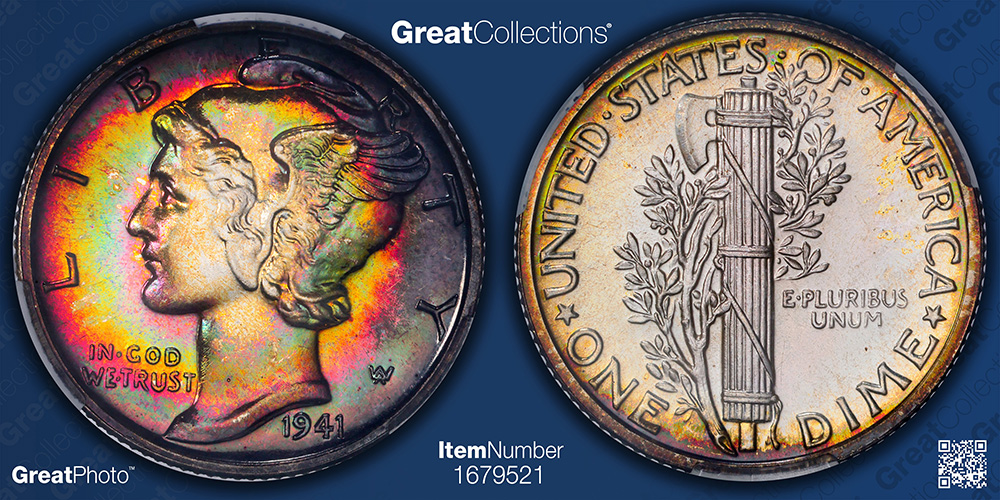
2. On Dec. 1, David Lawrence Rare Coins (DLRC) sold a CACG graded MS-64 1923-D Peace silver dollar for $485. On Dec. 18, Stack’s Bowers sold two PCGS graded MS-64 1923-D Peace silver dollars, neither of which had a CAC sticker, for $312 and $288, respectively.
3. On Dec. 5, DLRC sold a CACG graded AU-55 1805 half dollar for $8255. On June 17, Stack’s Bowers sold an NGC graded AU-55 1805 half dollar, without a CAC sticker, for $7200.
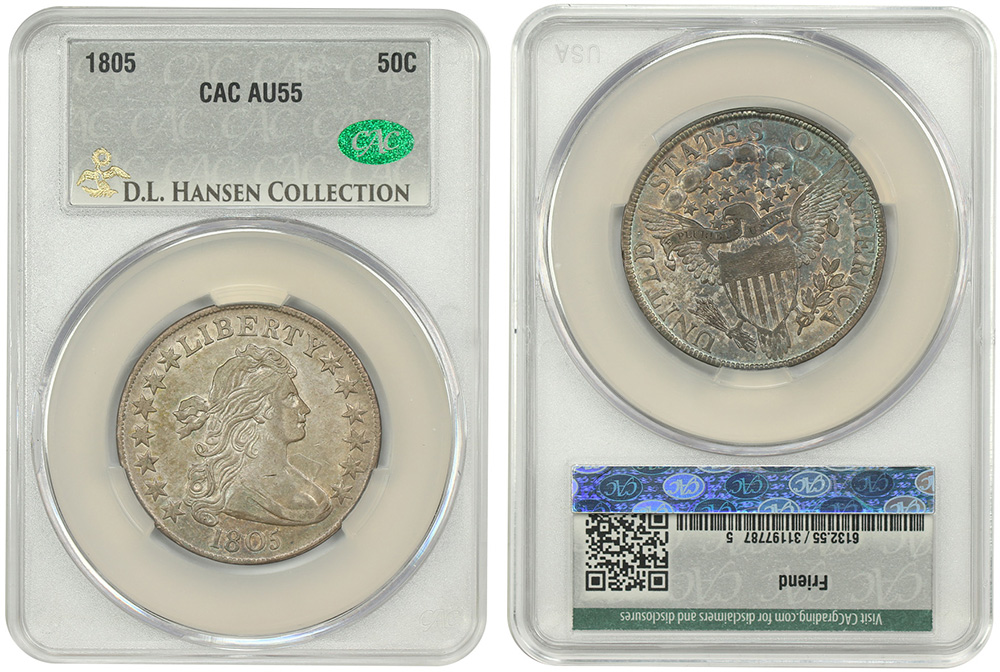
4. On Dec. 5, DLRC sold a CACG graded MS-67+ 1942-D half dollar for $3650. On Dec. 1, GreatCollections sold a PCGS graded MS-67+ 1942-D half dollar, without a CAC sticker, for $2035. On Sept. 1, GreatCollections sold a different PCGS graded MS-67+ 1942-D half dollar, without a CAC sticker, for $1843.60.
5. On Dec. 12, Heritage sold a CAC approved, PCGS certified Proof-66 1883 Trade dollar for $12,000. On Sept. 15, GreatCollections sold a PCGS certified Proof-66 1883 Trade dollar, without a CAC sticker, for $8800.
6. On Dec. 12, Heritage sold a CAC approved MS-64 grade 1893-O Morgan silver dollar for $33,600. On Nov. 21, Heritage sold a PCGS graded MS-64 grade 1893-O Morgan dollar, without a CAC sticker, for $13,614.
7. On Dec. 12. Heritage sold a CAC approved VF-30 grade 1871-CC $20 gold coin for $52,800. On Aug. 14, Heritage sold a PCGS graded XF-45 (forty-five) 1871-CC $20 gold coin, without a CAC sticker, for $39,600. A CAC stickered VF-30 (thirty) grade coin thus brought substantially more than a non-CAC PCGS graded XF-45 (forty-five) 1871-CC $20 gold coin.
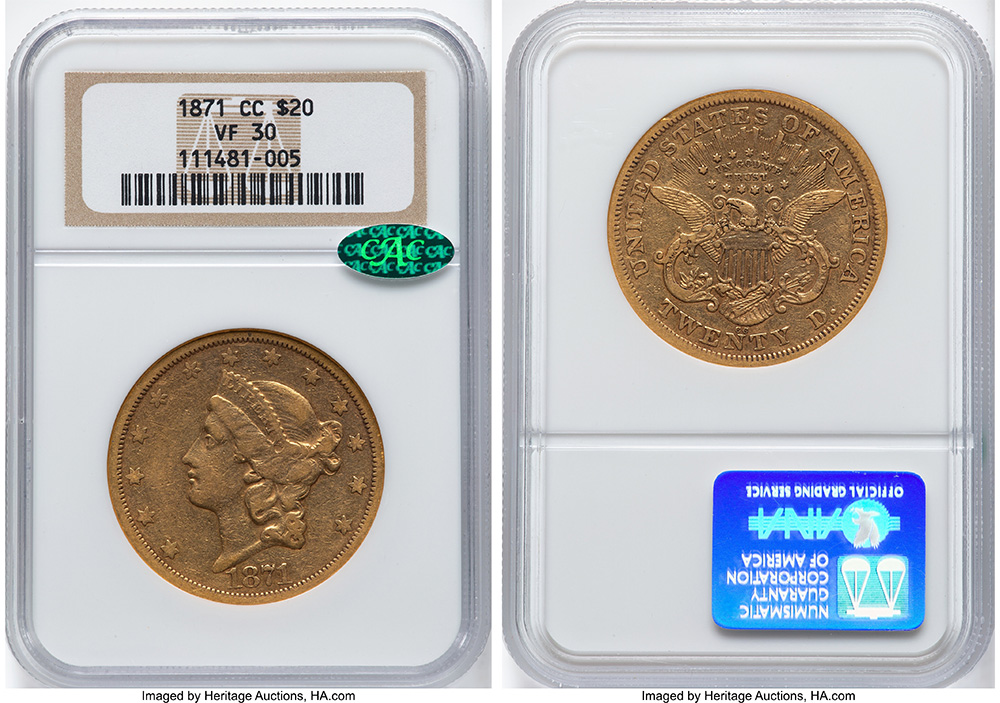
8. On Dec. 15, GreatCollections sold a CACG graded MS-64 1927 $2.5 gold coin for $885.50. On Dec. 8, GreatCollections sold a PCGS graded MS-64 1927 $2.5 gold coin, without a CAC sticker, for $660.
9. On Dec. 15, GreatCollections sold a CACG graded MS-67 1920 Pilgrim commemorative half dollar for $2475. On Dec. 8, GreatCollections sold a PCGS graded MS-67 1920 Pilgrim half, without a CAC sticker, for $1816.10. On Aug. 18, Heritage sold a PCGS graded MS-67 1920 Pilgrim half, without a CAC sticker, for $1800.
10. On Dec. 18, Stack’s Bowers auctioned a CAC approved Proof-67 1938 dime for $660. On Dec. 8, GreatCollections sold an NGC certified Proof-67 1938 dime, without a CAC sticker, for $382.80. On June 30, GreatCollections sold both a PCGS certified Proof-67 1938 dime and an NGC certified Proof-67 1938 dime, neither of which had a CAC sticker. The PCGS certified coin brought $423.50 and the NGC certified Proof-67 dime realized $474.10. It is true that a different CAC approved Proof-67 1938 dime was sold by Stack’s Bowers on Oct. 23 for $504, but it is also true that Stack’s Bowers sold still another CAC approved Proof-67 1938 dime for $960 on April 2. Though auction results vary, even if market levels remain the same, certified Proof-67 1938 dimes with CAC stickers generally brought significantly more than non-CAC, PCGS or NGC certified Proof-67 1938 dimes.
11. On Dec. 18, Stack’s Bowers auctioned a CAC approved, NGC graded MS-67 1943 half dollar for $720. On Dec. 17, Heritage sold an NGC graded MS-67 1943 half dollar, without a CAC sticker, for $360, half as much. On Dec. 15, GreatCollections sold a PCGS graded MS-67 1943 half dollar, without a CAC sticker, for $348.70, less than the just mentioned NGC certified coin and less than half as much as the cited NGC certified 1943 half with a CAC sticker.
Public sale prices for these tended to be higher in November. On Nov. 25, Stack’s Bowers sold a PCGS graded MS-67 1943 half dollar, without a CAC sticker, for $456. On Nov. 24, Great Collections sold an NGC graded MS-67 1943 half dollar, without a CAC sticker, for $396. It is true, however, that prices realized in November for non-CAC, PCGS or NGC graded MS-67 1943 half dollars were generally between $400 and $500, significantly less than the cited $720 price realized for a CAC approved, NGC graded MS-67 1943 half on Dec. 18.
12. On Dec. 18, Stack’s Bowers sold a CAC approved AU-58 grade 1854 Three Dollar Gold piece for $2520. On Dec. 9, Heritage auctioned an NGC graded AU-58 1854 Three Dollar Gold piece, without a CAC sticker, for $1740. On Nov. 26, Stack’s Bowers auctioned a PCGS graded AU-58 1854 Three Dollar Gold piece, without a CAC sticker, for this same price, $1740. On Nov. 24, Heritage auctioned a different PCGS graded AU-58 1854 Three Dollar Gold piece, without a CAC sticker, for $2040.
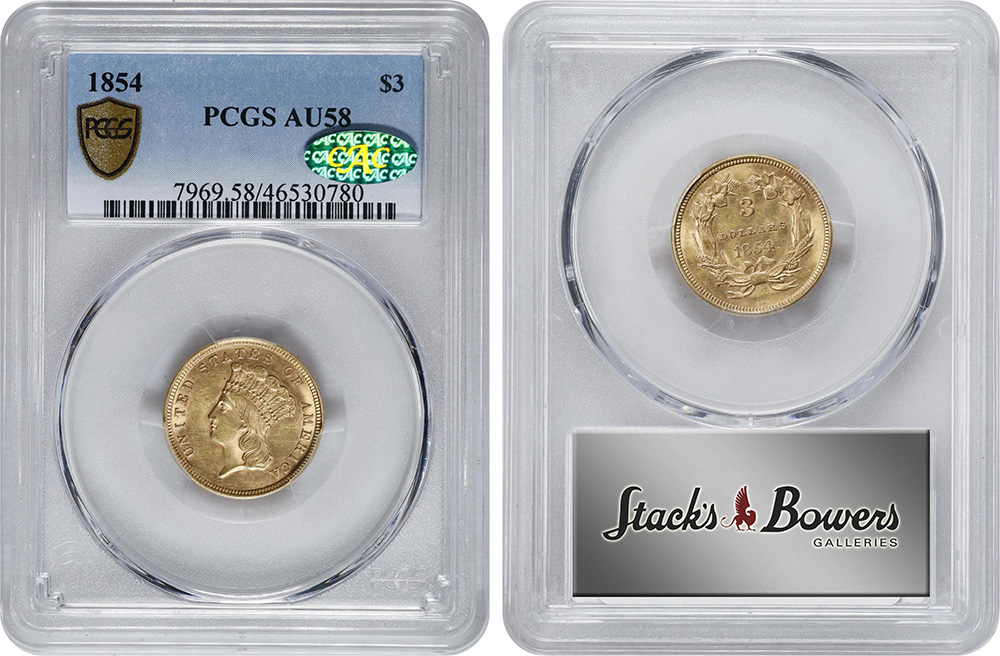

Download the Greysheet app for access to pricing, news, events and your subscriptions.
Subscribe Now.
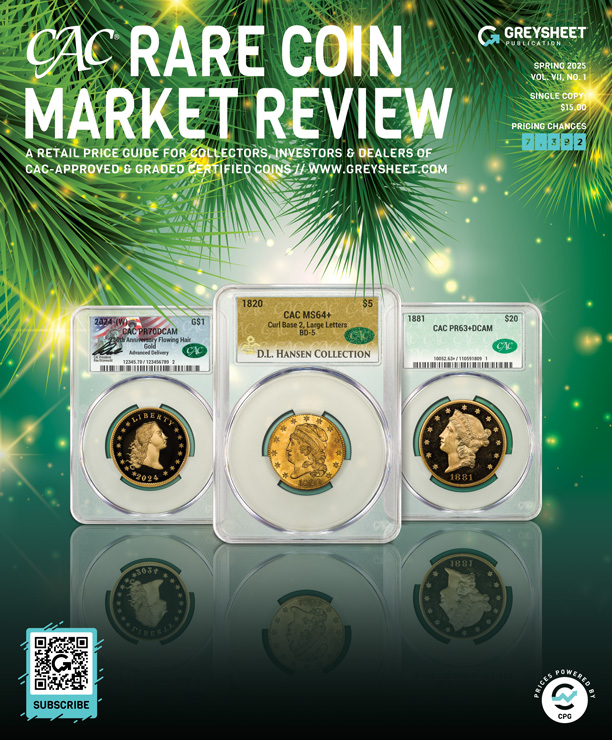
Subscribe to CAC Rare Coin Market Review for the industry's most respected pricing and to read more articles just like this.
Source: CAC Grading
CAC was formed in 2007 by John Albanese, a respected authority on coin grading and the rare coin market, along with twenty-two leading members of the numismatic community. Because certified coins of the same grade can be of varying quality, CAC’s mission was to advocate for the hobbyist by establishing an extremely stringent standard of grading. As a verifier of previously certified coins, CAC only recognizes coins that meet the highest standard with the now famous green sticker. Out of all the coins submitted to CAC, less than half receive the honorable CAC sticker. As a result, the CAC sticker serves as an unmistakable means of identifying premium coins for the grade.
In 2022, John Albanese assembled over one hundred and fifty leading members of the numismatic community with a purpose to reclaim accuracy and consistency in grading. After all, why merely sticker a previously certified coin when the same stringent standards can be applied within the context of a grading service? Thus, CAC Grading was born! The only difference now is the grade assigned to a coin is a true representation of that coin. Boasting a team of world-class graders including Ron Drzewucki, John Butler, among others, CAC is committed to applying an unparalleled level of expertise to every submitted coin. As a result, hobbyists can have total confidence in a coin certified by CAC.


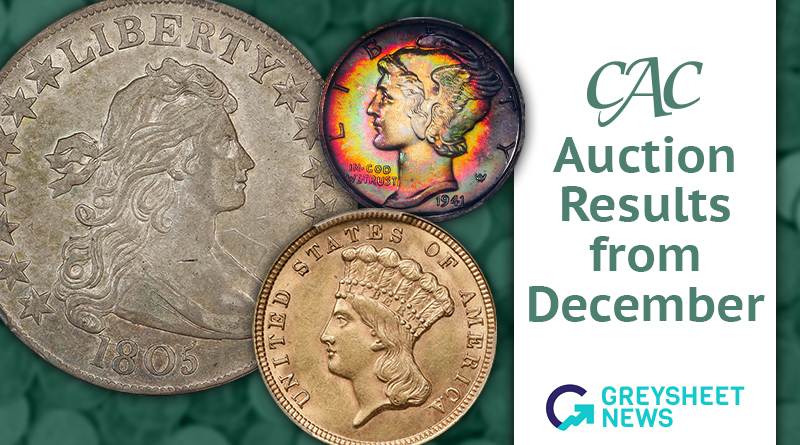




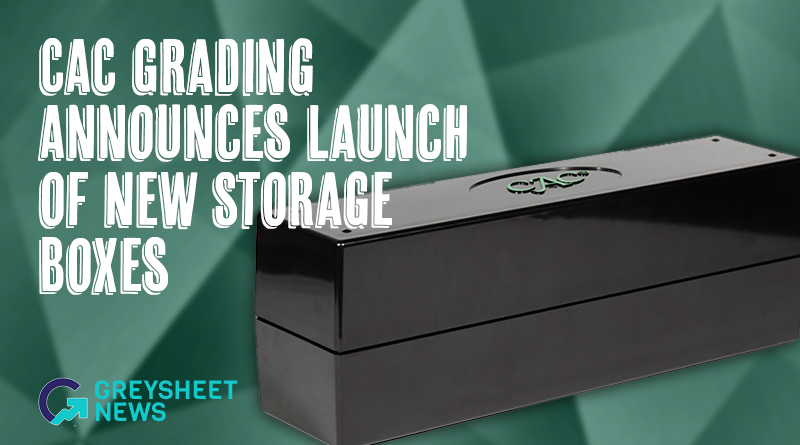
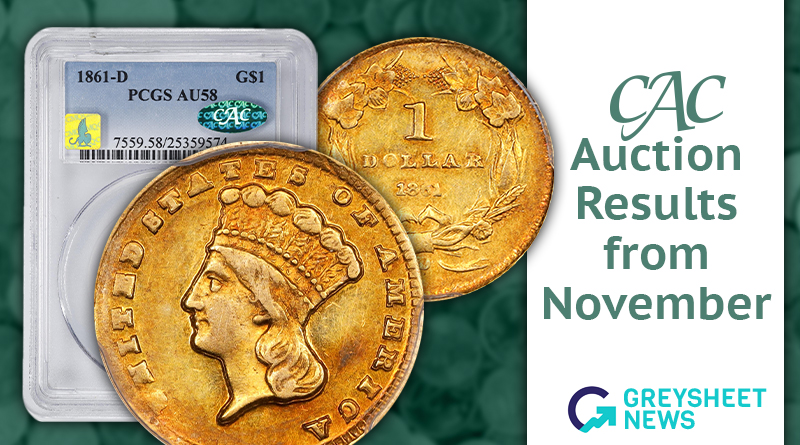
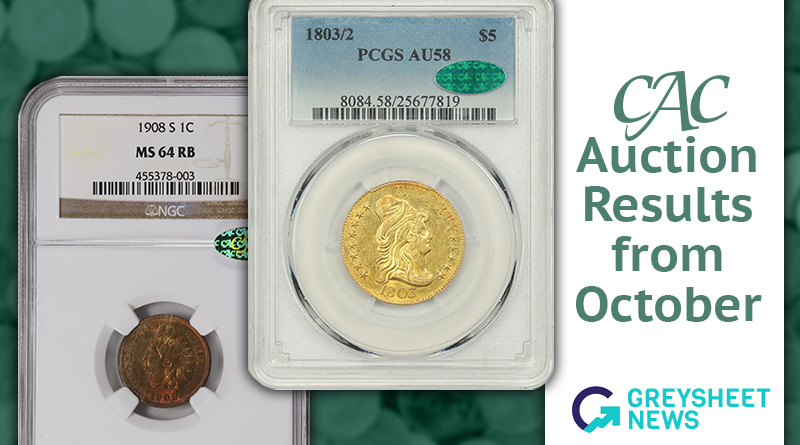
Please sign in or register to leave a comment.
Your identity will be restricted to first name/last initial, or a user ID you create.
Comment
Comments